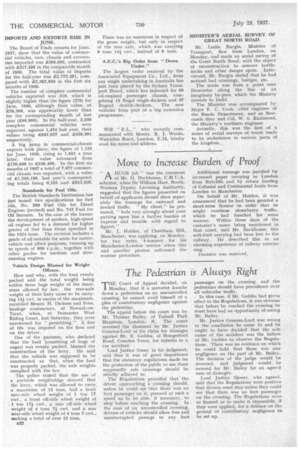IMPORTS AND EXPORTS RISE IN JUNE.
Page 36

If you've noticed an error in this article please click here to report it so we can fix it.
The Board of Trade returns for June, 1937, show that the value of commercial vehicles, cars, chassis and accessories imported was £395,692, contrasted with £317,495 in the comparable month of 1936. The total value of imports for the half-year was £2,772,381, compared .with £2,382,033 in the first six months of 1936.
The number of complete commercial vehicles exported was 319, which is slightly higher than the figure (275) for June, 1936, although their value, at £78,306, was appreciably lower than for the corresponding month of last year (£95,999). In the half-year, 2,338 complete commercial vehicles were exported, against 1,424 last year, their values being £597,027 and £428,981 respectively.
A big jump in commercial-chassis exports took place, the figure of 1,123 for June, 1936, rising to 1,501 a year later; their value advanced from £176,898 to £236,496. In the first six months of 1937 a total of 7,977 commercial chassis was exported, with a value of £1,256,196, last year's correspond-. ing totals being 6,161 and £913,836.
Standards for Fuel Oils.
The British Standards Institution has just issued two specifications for fuel oils, No. 209 Fuel Oils for Diesel Engines (revised) and No. 742 Fuel for Oil Burners. In the case of the former the development of modern, high-speed oil engines led to a demand for higher grades of fuel than those specified in the 1924 issue. The revision includes a grade of oil suitable for units for motorvehicle and allied purposes, running up to speeds of 800 r.p.m., together with other grades for medium and slowrunning engines.
Vehicle Design Blamed for Weight Offence.
How and why, with the load evenly packed add the total weight being within three bags weight of the maximum allowed by law, the rear-axle weight of their lorry came to be carrying 14/ cwt. in excess of the maximum, mystified Messrs. H. Dickens and Sons, haulage contractors, of Newark-onTrent, when, at Doncaster West Riding Court, last Saturday, they were summoned for " permitting." A fine of 10s. was imposed on the firm and on the driver.
One of the partners, who declared that the load (consisting of bags of sugar) was evenly packed, blamed the construction of the lorry. He said that the vehicle was supposed to be constructed so that, when the load was properly packed, the axle weights complied with the law.
The police stated that the use of
a portable weighbridge showed that the lorry, which was allowed to carry. a maximum of 12 tons, had a front near-side wheel weight of 1 ton 17 cwt., a front off-side wheel weight of
I ton 17/ cwt., a rear off-side wheel weight of 4 tons 7/ cwt. and a rear near-side wheel weight of 4 tons 7 cwt., making a total of over 12 tons.
B22 There was no summons in respect of the gross weight, but only in respect of the rear axle, which was carrying 8 tons 14/ cwt., instead of 8 tons.
A.E.C.'s Big Order from "Down Under."
The largest order received by the Associated Equipment Co., Ltd., from any single undertaking in Australia has just been placed by the Sydney Transport Board, which has indented for 50 oil-engined passenger chassis, comprising 13 Regal single-deckers and 37 Regent double-deckers. The new vehicles form part of a big extension programme.
Will " E.L.," who recently communicated with Messrs. R. J. Weeks, 1Araterden Road, London, E.15, kindly send his name and address. MINISTER'S AERIAL SURVEY OF GREAT NORTH ROAD.
Mr. Leslie Burgin, Minister of Transport, flew from London, on Monday, and made an aerial survey of the Great North Road, with the object of reconstruction to .remove bottlenecks and other danger spots. Interviewed, Mr. Burgin stated that he had noticed-bad crossings, bridges, etc.
The route was from a point near Doncaster along the line of an imaginary by-pass, which the Ministry intends to build.
The Minister was accompanied by Major F. C. Cook, chief engineer of the Roads Department, and at Newcastle they met Col. W. S. Richmond, the Ministry's northern engineer.
Actually, this was the first of a series of aerial surveys of trunk roads to be undertaken in various parts of the kingdom.




























































































